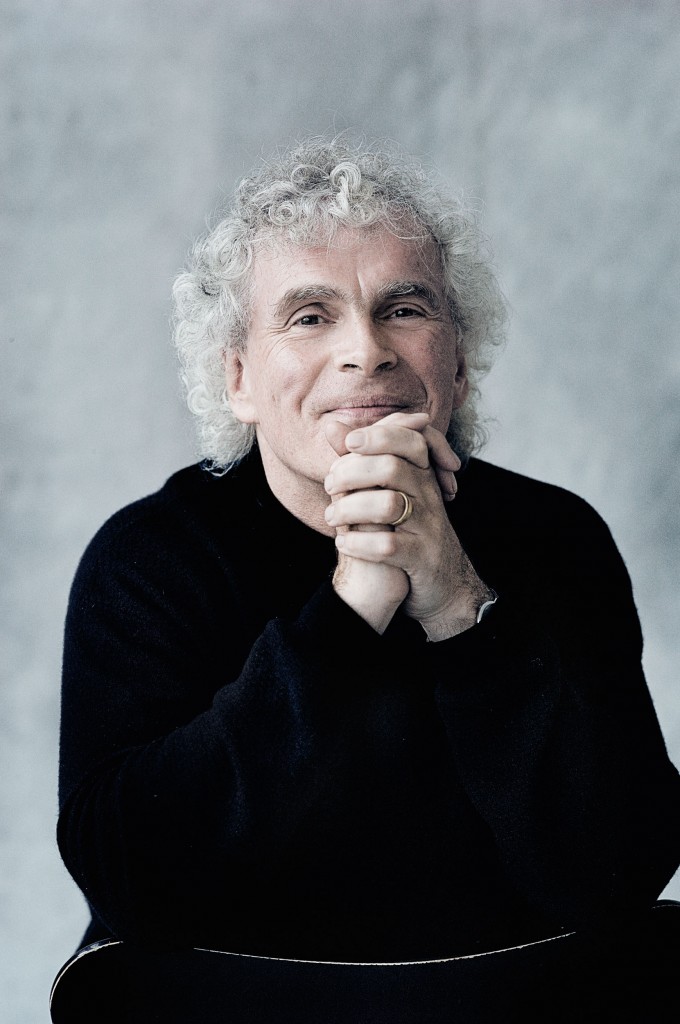Rattle, Berlin Philharmonic deliver an edgy, electrifying Beethoven Fifth

Sir Simon Rattle conducted the Berlin Philharmonic Orchestra in Beethoven’s Second and Fifth Symphonies Wednesday night at Carnegie Hall.
For the second installment of their weeklong Beethoven cycle at Carnegie Hall, Sir Simon Rattle and the Berlin Philharmonic Orchestra offered two contrasted symphonies and a rarely performed overture Wednesday night.
Playing to an almost-capacity house, the program led off with the Leonore Overture No. 1. Beethoven’s dissatisfaction with this first effort at a curtain-raiser to his opera Fidelio, motivated him to three more attempts. No. 1 remains the least often heard and one can readily understand why, with the opera’s revolutionary spirit muted in this Classically-scaled work; the sequence of rising and falling scales is not among Beethoven’s finest inspirations.
With the full-blooded commitment of the estimable Berlin players, Rattle seemed intent on making a case for the overture as something more than Ludwigian workbench shavings. Rather than try to avoid the episodic quality, Rattle embraced it, giving full voice and impact to each section, and bringing a searching, fantasia-like quality to the opening bars.
The rich, silvery corporate sonority of the storied Berlin ensemble under Rattle remains distinctive—nimble yet deep-cushioned strings allied to robust brass with a hint of grain, and elegant and wonderfully characterful woodwinds. A worthy case was made for the overture, but all sections were at their considerable finest in the two symphonies that made up the bulk of the evening.
The Second Symphony, in a sunny D major, is often regarded as a light Haydnesque work, representing “early Beethoven.” Yet in the kinetic performance led by the Philharmonic’s out-going music director, one was struck more by the Second’s commonalities with the Fifth’s minor-key drama than their differences.
Rattle and the orchestra presented the humor as having greater edge, and the vitality, a jumpy quality that seemed anything but relaxed. Dynamic contrasts in the opening Allegro were forcefully punched out, and the playing went with a bristling urgency. Taken at a fleet walking pace, the Andante was all of a piece, light on charm with little easing of tension in the brusque accents.
The performance was rounded off with a fast and extraordinarily well-played finale that finally let a smile creep into the high-spirited vehemence. The opening somersault motif was thrown off so quickly and with such offhand bravura that one almost had to laugh out loud (and some did). Rattle ratcheted up the nervy virtuosity of the Berlin musicians to an aggressively brilliant coda.
If the vehemence missed some charm in the Second, Rattle and the orchestra were at their finest in the craggy C-minor drama of the Fifth Symphony. The swift, fluent take on the famous motif went with uncommon freshness and urgency, choral attacks explosive yet kept in scale. In an Andante of noble, stately elegance, the woodwinds echoed each other’s phrases closely and the extra surge of the main theme at the coda made a warm, heart-easing impact.
Rattle builds textures from the ground up and one was continually struck by the weight and fullness of the Berlin sonority that yet remained light and transparent. The gleaming refinement and meticulously balanced textures were as distinctive as the ensemble cohesion–so seamless it was unnerving.
Solos had personality-plus individuality as with the spacious, aria-like oboe in the first movement. One was relieved to hear a fractional slip in the strings or momentary bassoon imperfection as a reminder of the human qualities that create such unworldly virtuosity. Also notable was the almost physical commitment of all the musicians, with even the back-bench violins fairly leaping off their chairs with the intensity of their playing.
The performance of the Fifth culminated in a finale that somehow managed to strip decades of kinda-sorta rote-drama shellack from this score. The mystery of the rumbling basses and the ease into the finale’s opening had extraordinary tension and concentration with the burst of sunlit brilliance electrifying. En route, Rattle uncovered scoring details rarely plumbed even in this score, like the crazed flute leaps and the violas’ hectic counterpoint
The exuberance of the music-making was so completely involving and exhilarating that one could feel one’s heart-rate involuntarily accelerating and breathing getting faster. The joyous fury of the final bars culminated in a quick accelerando on the last chords that closed a fiery and memorable performance. Loud ovations, cheers and repeated curtain calls for Rattle, who went into the orchestra shaking hands and acknowledging his principals.
“You’ll never hear it played better,” said a colleague. And it was hard to disagree.
Simon Rattle leads the Berlin Philharmonic Orchestra in Beethoven’s Symphonies Nos. 6 and 8 at Carnegie Hall 8 p.m. Thursday. carnegiehall.org




Posted Nov 22, 2015 at 1:01 pm by Brett
I was sitting next to a professional conductor and we both agreed that it was the best Fifth we’d ever heard. Absolutely electrifying and amazing refreshing, which is a considerable feat with such an overexposed work. Stunning.
Posted Nov 22, 2015 at 1:12 pm by Brent
Thanks for the review, which conveyed about as much of the concert as one can with words. I have had some memorable concert experiences, many with this ensemble, but I have never experienced anything in or out of music like Wednesday’s performance of the Fifth.
I wasn’t particularly excited since it’s overexposure leaves even excellent performances dull at times. Not so with Rattle’s. The energy and explosiveness of passages was somehow coupled with an uncanny rhythmic nimbleness. The physiological response you describe was ubiquitous. Having seen their entire cycle, which was mostly (though not entirely) excellent, this was the jewel. A performance I will cherish all my life. — BB
Posted Nov 23, 2015 at 2:58 pm by Stephen schreiber
Wonderful review!!! I have been looking for one all week.